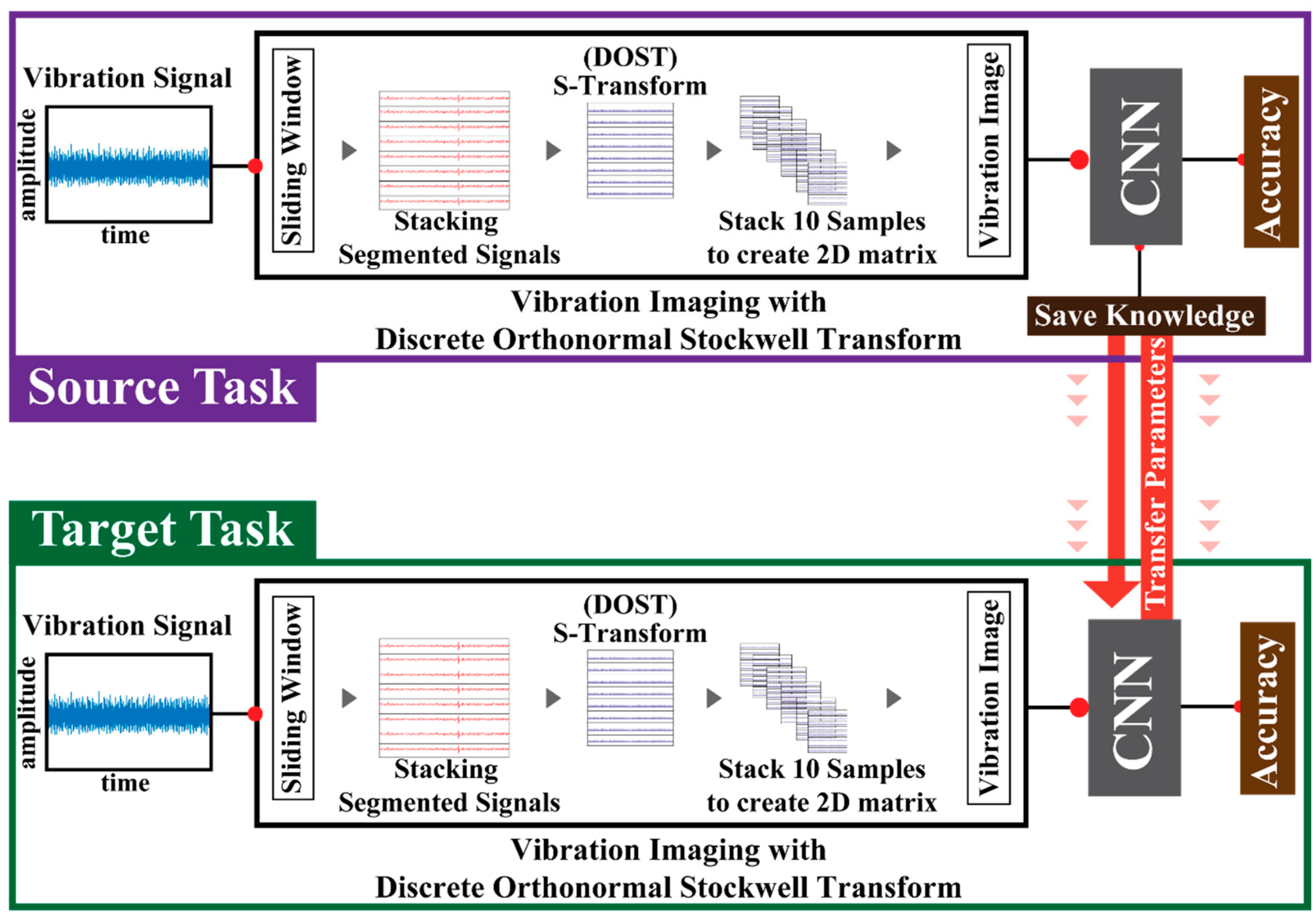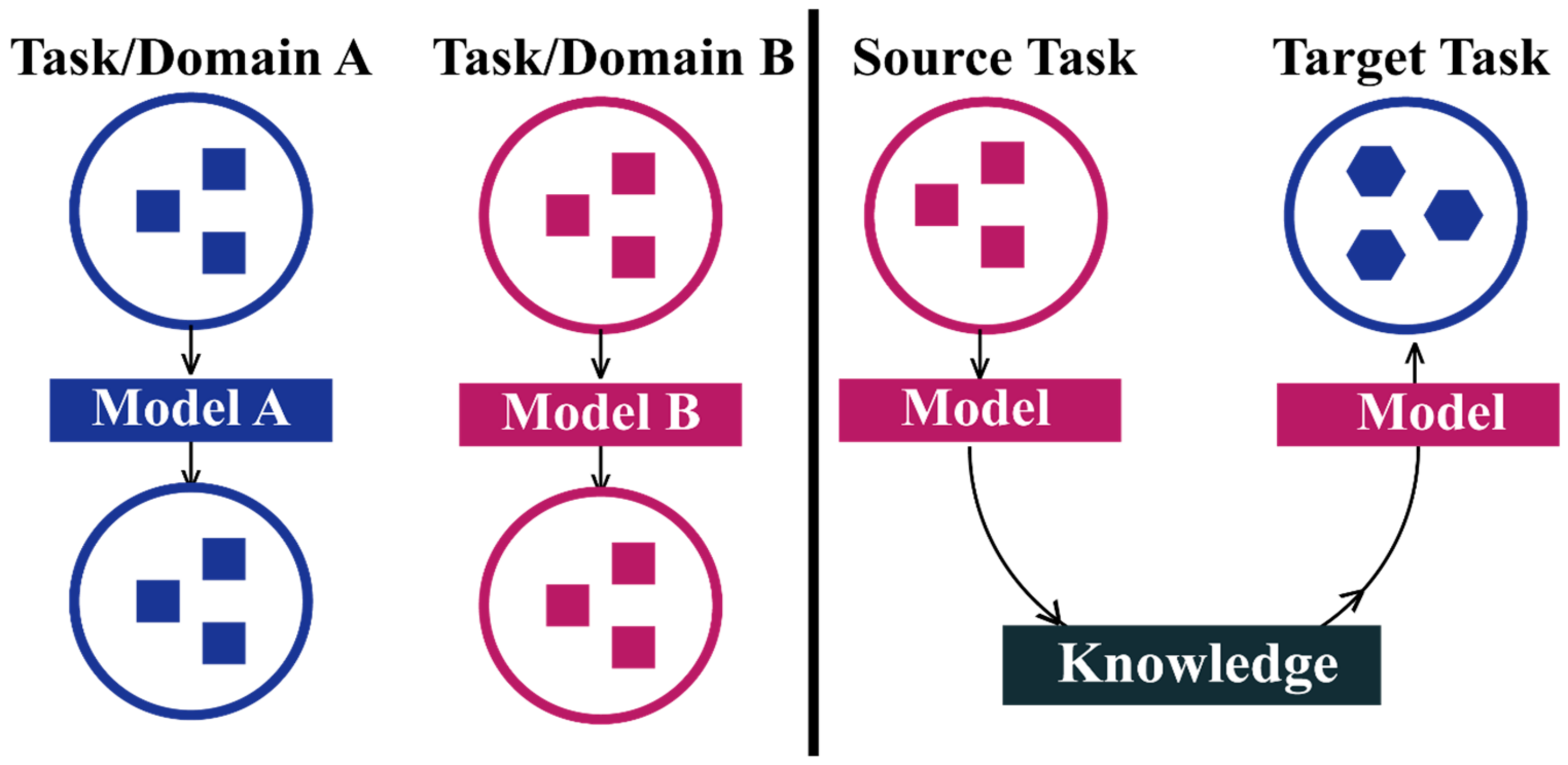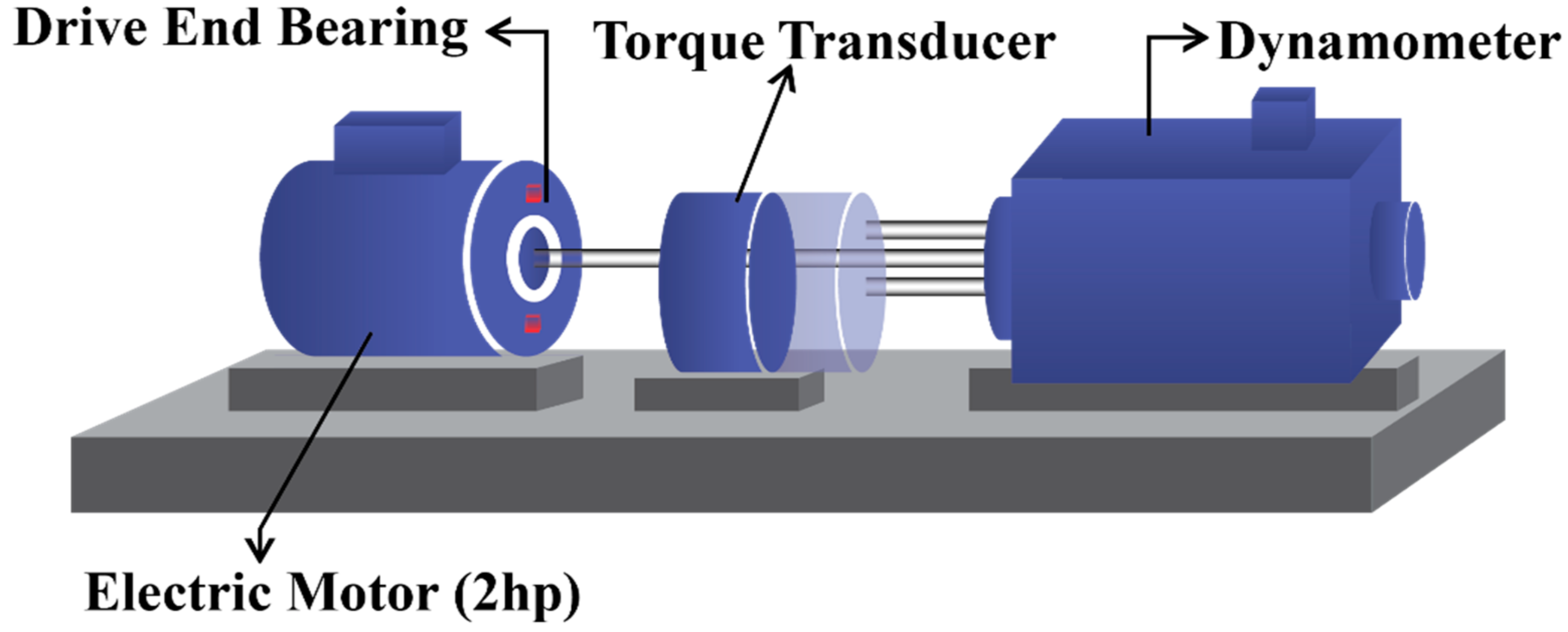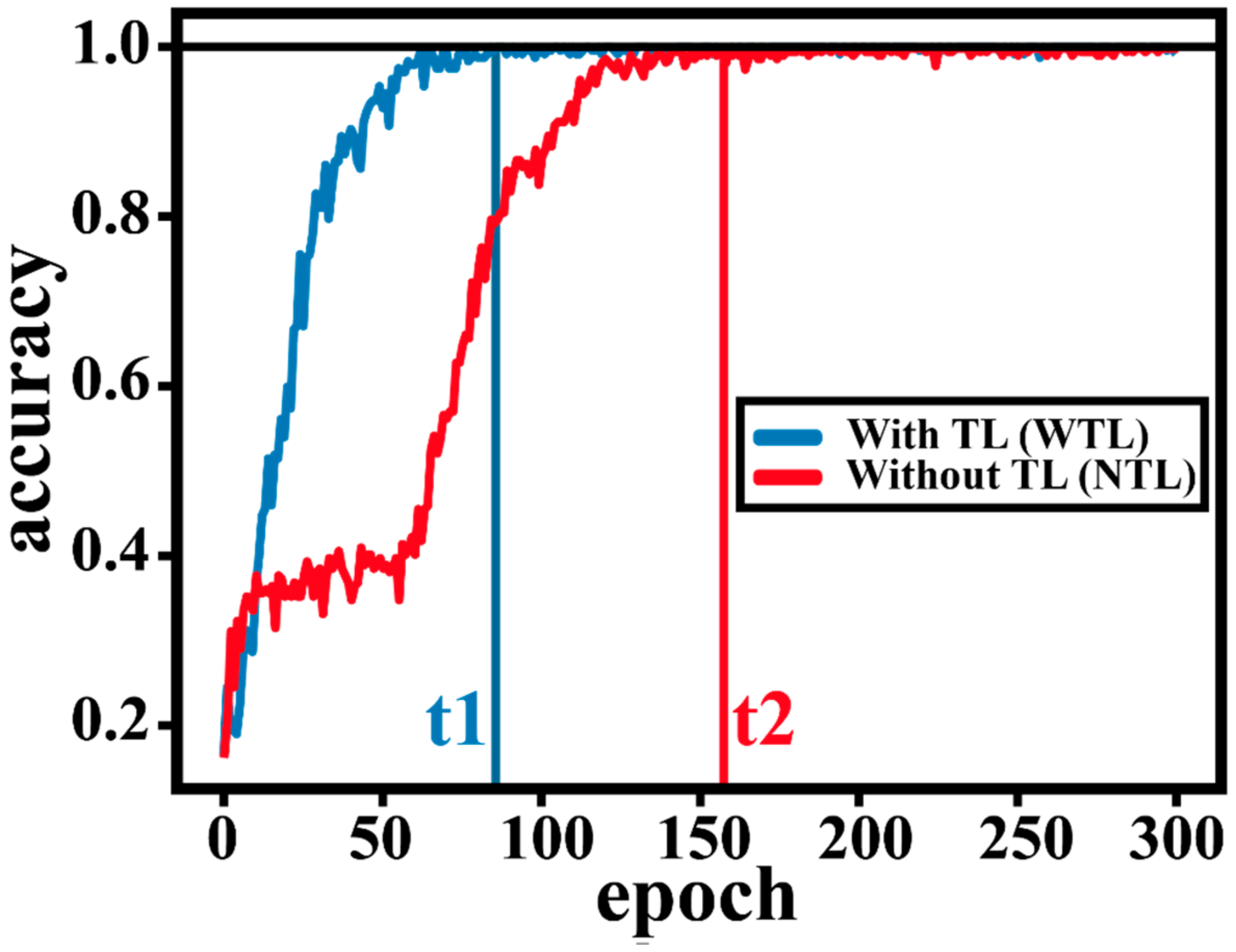Bearing Fault Diagnosis under Variable Rotational Speeds Using Stockwell Transform-Based Vibration Imaging and Transfer Learning
Abstract
:1. Introduction
2. Methodology
2.1. Vibration Imaging Using Discrete Orthonormal Stockwell Transform (DOST)
2.2. Transfer Learning with Convolutional Neural Network (CNN)
3. Result Analysis
3.1. Dataset and Experimental Working Conditions
3.2. Analysis of 2D Vibration Imaging
3.3. Diagnostic Performance of the Proposed TL-Based Method
3.4. Comparison Analysis
4. Conclusions
Author Contributions
Funding
Conflicts of Interest
References
- Saidur, R. A review on electrical motors energy use and energy savings. Renew. Sustain. Energy Rev. 2010, 14, 877–898. [Google Scholar] [CrossRef]
- Khan, S.A.; Kim, J.M. Automated bearing fault diagnosis using 2d analysis of vibration acceleration signals under variable speed conditions. Shock Vib. 2016, 2016, 8729572. [Google Scholar] [CrossRef]
- El-Thalji, I.; Jantunen, E. Dynamic modelling of wear evolution in rolling bearings. Tribol. Int. 2015, 84, 90–99. [Google Scholar] [CrossRef]
- Zhang, R.; Peng, Z.; Wu, L.; Yao, B.; Guan, Y. Fault diagnosis from raw sensor data using deep neural networks considering temporal coherence. Sensors 2017, 17, 549. [Google Scholar] [CrossRef] [PubMed]
- Jiang, X.; Wu, L.; Ge, M. A novel faults diagnosis method for rolling element bearings based on ewt and ambiguity correlation classifiers. Entropy 2017, 19, 231. [Google Scholar] [CrossRef]
- Sohaib, M.; Kim, C.-H.; Kim, J.-M. A hybrid feature model and deep-learning-based bearing fault diagnosis. Sensors 2017, 17, 2876. [Google Scholar] [CrossRef] [PubMed]
- Li, S.; Liu, G.; Tang, X.; Lu, J.; Hu, J. An ensemble deep convolutional neural network model with improved d-s evidence fusion for bearing fault diagnosis. Sensors 2017, 17, 1729. [Google Scholar] [CrossRef] [PubMed]
- Thorsen, O.V.; Dalva, M. Failure identification and analysis for high-voltage induction motors in the petrochemical industry. IEEE Trans. Ind. Appl. 1999, 35, 810–818. [Google Scholar] [CrossRef]
- Tra, V.; Kim, J.; Khan, S.A.; Kim, J.-M. Incipient fault diagnosis in bearings under variable speed conditions using multiresolution analysis and a weighted committee machine. J. Acoust. Soc. Am. 2017, 142, EL35–EL41. [Google Scholar] [CrossRef] [PubMed] [Green Version]
- Jardine, A.K.S.; Lin, D.; Banjevic, D. A review on machinery diagnostics and prognostics implementing condition-based maintenance. Mech. Syst. Signal Process. 2006, 20, 1483–1510. [Google Scholar] [CrossRef]
- Mendizabal, X.; Arnaiz, A. Ball bearing damage detection using traditional signal processing algorithms. IEEE Instrum. Meas. Mag. 2013, 16, 20–25. [Google Scholar]
- Zhao, S.; Liang, L.; Xu, G.; Wang, J.; Zhang, W. Quantitative diagnosis of a spall-like fault of a rolling element bearing by empirical mode decomposition and the approximate entropy method. Mech. Syst. Signal Process. 2013, 40, 154–177. [Google Scholar] [CrossRef]
- Yin, S.; Ding, S.X.; Zhou, D. Diagnosis and prognosis for complicated industrial systems—Part I. IEEE Trans. Ind. Electron. 2016, 63, 2501–2505. [Google Scholar] [CrossRef]
- Yin, S.; Ding, S.X.; Zhou, D. Diagnosis and prognosis for complicated industrial systems—Part II. IEEE Trans. Ind. Electron. 2016, 63, 3201–3204. [Google Scholar] [CrossRef]
- Qin, X.; Li, Q.; Dong, X.; Lv, S. The fault diagnosis of rolling bearing based on ensemble empirical mode decomposition and random forest. Shock Vib. 2017, 2017, 2623081. [Google Scholar] [CrossRef]
- Huang, W.; Sun, H.; Wang, W. Resonance-based sparse signal decomposition and its application in mechanical fault diagnosis: A review. Sensors 2017, 17, 1279. [Google Scholar] [CrossRef] [PubMed]
- Duong, B.P.; Kim, J.M. Non-Mutually Exclusive Deep Neural Network Classifier for Combined Modes of Bearing Fault Diagnosis. Sensors 2018, 18, 1129. [Google Scholar] [CrossRef] [PubMed]
- Khan, S.A.; Kim, J.-M. Rotational speed invariant fault diagnosis in bearings using vibration signal imaging and local binary patterns. J. Acoust. Soc. Am. 2016, 139, EL100–EL104. [Google Scholar] [CrossRef] [PubMed]
- Soualhi, A.; Clerc, G.; Razik, H. Detection and diagnosis of faults in induction motor using an improved artificial ant clustering technique. IEEE Trans. Ind. Electron. 2013, 60, 4053–4062. [Google Scholar] [CrossRef]
- Kim, B.S.; Lee, S.H.; Lee, M.G.; Ni, J.; Song, J.Y.; Lee, C.W. A comparative study on damage detection in speed-up and coast-down process of grinding spindle-typed rotor-bearing system. J. Mater. Process. Technol. 2007, 187–188, 30–36. [Google Scholar] [CrossRef]
- Tahir, M.M.; Khan, A.Q.; Iqbal, N.; Hussain, A.; Badshah, S. Enhancing fault classification accuracy of ball bearing using central tendency based time domain features. IEEE Access 2017, 5, 72–83. [Google Scholar] [CrossRef]
- Huo, Z.; Zhang, Y.; Francq, P.; Shu, L.; Huang, J. Incipient fault diagnosis in roller bearing using optimized wavelet transform based on multi-speed vibration signatures. IEEE Access 2017, 5, 19442–19456. [Google Scholar] [CrossRef]
- Wang, W.; Lee, H. An energy kurtosis demodulation technique for signal denoising and bearing fault detection. Meas. Sci. Technol. 2013, 24, 025601. [Google Scholar] [CrossRef]
- Yang, Y. A signal theoretic approach for envelope analysis of real-valued signals. IEEE Access 2017, 5, 5623–5630. [Google Scholar] [CrossRef]
- Sugumaran, V.; Ramachandran, K.I. Effect of number of features on classification of roller bearing faults using svm and psvm. Expert Syst. Appl. 2011, 38, 4088–4096. [Google Scholar] [CrossRef]
- Saimurugan, M.; Ramachandran, K.I.; Sugumaran, V.; Sakthivel, N.R. Multi component fault diagnosis of rotational mechanical system based on decision tree and support vector machine. Expert Syst. Appl. 2011, 38, 3819–3826. [Google Scholar] [CrossRef]
- Shao, H.; Jiang, H.; Lin, Y.; Li, X. A novel method for intelligent fault diagnosis of rolling bearings using ensemble deep auto-encoders. Mech. Syst. Signal Process. 2018, 102, 278–297. [Google Scholar] [CrossRef]
- Sohaib, M.; Kim, J.-M. Reliable fault diagnosis of rotary machine bearings using a stacked sparse autoencoder-based deep neural network. Shock Vib. 2018, 2018, 2919637. [Google Scholar] [CrossRef]
- Lu, C.; Wang, Z.; Zhou, B. Intelligent fault diagnosis of rolling bearing using hierarchical convolutional network based health state classification. Adv. Eng. Inform. 2017, 32, 139–151. [Google Scholar] [CrossRef]
- Stockwell, R.G. A basis for efficient representation of the s-transform. Digit. Signal Process. Rev. J. 2007, 17, 371–393. [Google Scholar] [CrossRef]
- Appana, D.K.; Ahmad, W.; Kim, J.-M. Speed invariant bearing fault characterization using convolutional neural networks. In Multi-Disciplinary Trends in Artificial Intelligence; Phon-Amnuaisuk, S., Ang, S.-P., Lee, S.-Y., Eds.; Springer International Publishing: Cham, Switzerland, 2017; pp. 189–198. [Google Scholar]
- Malek, S.; Melgani, F.; Bazi, Y. One-dimensional convolutional neural networks for spectroscopic signal regression. J. Chemom. 2018, 32, e2977. [Google Scholar] [CrossRef]
- Zhang, R.; Tao, H.; Wu, L.; Guan, Y. Transfer learning with neural networks for bearing fault diagnosis in changing working conditions. IEEE Access 2017, 5, 14347–14357. [Google Scholar] [CrossRef]
- Cao, P.; Zhang, S.; Tang, J. Preprocessing-free gear fault diagnosis using small datasets with deep convolutional neural network-based transfer learning. IEEE Access 2018, 6, 26241–26253. [Google Scholar] [CrossRef]
- Stockwell, R.G.; Mansinha, L.; Lowe, R.P. Localization of the complex spectrum: The s transform. IEEE Trans. Signal Process. 1996, 44, 998–1001. [Google Scholar] [CrossRef]
- Battisti, U.; Riba, L. Window-dependent bases for efficient representations of the stockwell transform. Appl. Comput. Harmonic Anal. 2016, 40, 292–320. [Google Scholar] [CrossRef]
- Kaba, M.D.; Camlibel, M.K.; Wang, Y.; Orchard, J. Fast discrete orthonormal stockwell transform. SIAM J. Sci. Comput. 2009, 31, 4000–4012. [Google Scholar]
- Shie, C.-K.; Chuang, C.-H.; Chou, C.-N.; Wu, M.-H.; Chang, E.Y. Transfer representation learning for medical image analysis. In Proceedings of the 37th Annual International Conference of the IEEE Engineering in Medicine and Biology Society (EMBC), Milano, Italy, 25–29 August 2015. [Google Scholar]
- LeCun, Y.; Bottou, L.; Bengio, Y.; Haffner, P. Gradient-based learning applied to document recognition. Proc. IEEE 1998, 86, 2278–2323. [Google Scholar] [CrossRef]
- Tra, V.; Kim, J.; Khan, S.A.; Kim, J.-M. Bearing fault diagnosis under variable speed using convolutional neural networks and the stochastic diagonal levenberg-marquardt algorithm. Sensors 2017, 17, 2834. [Google Scholar] [CrossRef] [PubMed]
- Case Western Reserve University. Bearing Data Center Website. Available online: https://csegroups.case.edu/bearingdatacenter/pages/welcome-case-western-reserve-university-bearing-data-center-website (accessed on 13 July 2018).








| Stage | Stage Specification | Layer No. | Layer Name in Network | Transfer |
|---|---|---|---|---|
| 1 | Training stage | 01 | Convolutional | Yes |
| 02 | Maxpooling | Yes | ||
| 03 | Dropout | Yes | ||
| 2 | Training stage | 04 | Convolutional | Yes |
| 05 | Maxpooling | Yes | ||
| 06 | Fully connected | Yes | ||
| 3 | Training stage | 07 | Dropout | Yes |
| 08 | Fully connected | Yes | ||
| 4 | Output stage | 09 | Fully connected | No |
| Fs = 12 kHZ | Health Type | Motor Load | Motor Speed | Crack Size |
|---|---|---|---|---|
| Diameter (Inches) | ||||
| Working Condition 1 | Healthy Condition (HC) | 0 | 1797 Rounds/min | Nil |
| Inner Race Fault (IRF) | 0 | 1797 Rounds/ min | 0.007 | |
| Ball Fault (BF) | 0 | 1797 Rounds/min | 0.007 | |
| Outer Race Fault at center (ORF@12) | 0 | 1797 Rounds/min | 0.007 | |
| Outer Race Fault at orthogonal (ORF@3) | 0 | 1797 Rounds/min | 0.007 | |
| Outer Race Fault at opposite (ORF@6) | 0 | 1797 Rounds/min | 0.007 | |
| Working Condition 2 | Healthy Condition (HC) | 1 | 1772 Rounds/min | Nil |
| Inner Race Fault (IRF) | 1 | 1772 Rounds/min | 0.007 | |
| Ball Fault (BF) | 1 | 1772 Rounds/min | 0.007 | |
| Outer Race Fault at center (ORF@12) | 1 | 1772 Rounds/min | 0.007 | |
| Outer Race Fault at orthogonal (ORF@3) | 1 | 1772 Rounds/min | 0.007 | |
| Outer Race Fault at opposite (ORF@6) | 1 | 1772 Rounds/min | 0.007 | |
| Working Condition 3 | Healthy Condition (HC) | 2 | 1750 Rounds/min | Nil |
| Inner Race Fault (IRF) | 2 | 1750 Rounds/min | 0.007 | |
| Ball Fault (BF) | 2 | 1750 Rounds/min | 0.007 | |
| Outer Race Fault at center (ORF@12) | 2 | 1750 Rounds/min | 0.007 | |
| Outer Race Fault at orthogonal (ORF@3) | 2 | 1750 Rounds/min | 0.007 | |
| Outer Race Fault at opposite (ORF@6) | 2 | 1750 Rounds/min | 0.007 | |
| Working Condition 4 | Healthy Condition (HC) | 3 | 1730 Rounds/min | Nil |
| Inner Race Fault (IRF) | 3 | 1730 Rounds/min | 0.007 | |
| Ball Fault (BF) | 3 | 1730 Rounds/min | 0.007 | |
| Outer Race Fault at center (ORF@12) | 3 | 1730 Rounds/min | 0.007 | |
| Outer Race Fault at orthogonal (ORF@3) | 3 | 1730 Rounds/min | 0.007 | |
| Outer Race Fault at opposite (ORF@6) | 3 | 1730 Rounds/min | 0.007 |
| Scenario | Source Dataset | Target Dataset | Classification Accuracy (%) | Average Classification Accuracy (%) | Overall Classification Accuracy (%) | |||||
|---|---|---|---|---|---|---|---|---|---|---|
| HC | IRF | BF | ORF@12 | ORF@3 | ORF@6 | |||||
| 1 | WC 1 | WC 2 | 100 | 100 | 100 | 100 | 100 | 100 | 100 | 99.99 |
| WC 3 | 100 | 100 | 100 | 100 | 100 | 100 | 100 | |||
| WC 4 | 100 | 99.88 | 100 | 100 | 100 | 100 | 99.98 | |||
| 2 | WC 2 | WC 1 | 100 | 100 | 100 | 100 | 100 | 100 | 100 | 99.98 |
| WC 3 | 100 | 100 | 100 | 100 | 100 | 100 | 100 | |||
| WC 4 | 100 | 100 | 100 | 99.69 | 100 | 100 | 99.95 | |||
| 3 | WC 3 | WC 1 | 100 | 100 | 100 | 100 | 100 | 100 | 100 | 99.90 |
| WC 2 | 100 | 100 | 100 | 98.44 | 100 | 100 | 99.74 | |||
| WC 4 | 100 | 99.83 | 100 | 100 | 100 | 100 | 99.97 | |||
| 4 | WC 4 | WC 1 | 99.94 | 98.68 | 99.47 | 100 | 99.92 | 99.29 | 99.55 | 99.54 |
| WC 2 | 99.96 | 99.73 | 100 | 99.63 | 99.68 | 99.57 | 99.76 | |||
| WC 3 | 99.98 | 98.22 | 100 | 98.37 | 99.53 | 99.79 | 99.32 | |||
| Average Accuracy (%) | 99.99 | 99.95 | 99.96 | 99.68 | 99.93 | 99.89 | 99.86 | 99.85 | ||
| Scenario | Overall Classification Accuracy (%) | |||
|---|---|---|---|---|
| Training Data 80% | Training Data 60% | Training Data 40% | Training Data 20% | |
| 1 | 99.99 | 96.44 | 86.22 | 79.18 |
| 2 | 99.98 | 96.23 | 86.45 | 77.43 |
| 3 | 99.90 | 95.82 | 85.32 | 77.92 |
| 4 | 99.54 | 95.59 | 83.96 | 67.11 |
| Scenario | Overall Classification Accuracy with Transfer Learning (TL) (%) | ||
|---|---|---|---|
| Transfer Stages 1–3 | Transfer Stages 1–2 | Transfer Stage 1 | |
| 1 | 99.99 | 93.44 | 79.61 |
| 2 | 99.98 | 93.31 | 79.22 |
| 3 | 99.90 | 93.49 | 78.13 |
| 4 | 99.54 | 92.61 | 77.29 |
| Health Types | WTL (%) | NTL (%) | Improvements (%) |
|---|---|---|---|
| HC | 100 | 100 | 0 |
| IRF | 95.72 | 97.92 | −2.2 |
| BF | 96.22 | 95.2 | 1.02 |
| ORF@12 | 96.79 | 93.41 | 3.38 |
| ORF@3 | 97.21 | 94.90 | 2.31 |
| ORF@6 | 93.11 | 91.39 | 1.72 |
| Overall | 96.51 | 95.47 | 1.04 |
| Scenario | Method | Classification Accuracy (%) | Average Accuracy (%) | Improvement (%) [Proposed Method] | |||||
|---|---|---|---|---|---|---|---|---|---|
| HC | IRF | BF | ORF@12 | ORF@3 | ORF@6 | ||||
| 1 | ANN | 70.29 | 68.22 | 67.45 | 64.92 | 65.79 | 67.39 | 67.34 | 32.65 |
| SVM | 82.43 | 80.33 | 83.22 | 85.29 | 81.22 | 80.19 | 82.11 | 17.88 | |
| [29] | 93.44 | 93.2 | 93.79 | 93.72 | 92.69 | 92.44 | 93.21 | 6.78 | |
| [27] | 97.22 | 97.39 | 98.2 | 97.93 | 97.51 | 97.63 | 97.65 | 2.34 | |
| [33] | 100 | 93.2 | 96.45 | 94.2 | 94 | 93.55 | 95.23 | 4.76 | |
| Proposed | 100 | 99.96 | 100 | 100 | 100 | 100 | 99.99 | - | |
| 2 | ANN | 70.11 | 69.9 | 67.96 | 64.11 | 64.7 | 67.49 | 67.38 | 32.60 |
| SVM | 81.9 | 82.3 | 82.57 | 85.39 | 81.83 | 81.29 | 82.55 | 17.43 | |
| [29] | 93.39 | 93.86 | 93.5 | 93.29 | 92.98 | 92.95 | 93.33 | 6.65 | |
| [27] | 97.86 | 97.19 | 97.49 | 97.3 | 97.59 | 97.77 | 97.53 | 2.45 | |
| [33] | 100 | 93.2 | 96.45 | 94.2 | 94 | 93.55 | 95.28 | 4.7 | |
| Proposed | 100 | 99.96 | 100 | 100 | 100 | 100 | 99.98 | - | |
| 3 | ANN | 69.3 | 67.22 | 67.1 | 64.92 | 64.6 | 66.13 | 66.55 | 32.31 |
| SVM | 82.72 | 82.9 | 83.17 | 86.22 | 83.2 | 82.57 | 83.46 | 16.39 | |
| [29] | 92.63 | 93.12 | 92.86 | 92.77 | 92.09 | 92.13 | 92.6 | 7.25 | |
| [27] | 97.1 | 96.33 | 97.78 | 97.5 | 97.61 | 97.21 | 97.26 | 2.6 | |
| [33] | 100 | 93.2 | 96.45 | 94.2 | 94 | 93.55 | 95.26 | 4.59 | |
| Proposed | 100 | 99.96 | 100 | 100 | 100 | 100 | 99.85 | - | |
| 4 | ANN | 67.2 | 66.9 | 65.3 | 63.82 | 64.9 | 63.92 | 65.34 | 34.2 |
| SVM | 80.1 | 81.95 | 82.3 | 84.29 | 81.22 | 79.49 | 81.56 | 17.98 | |
| [29] | 93.87 | 92.91 | 92.94 | 92.7 | 91.19 | 91.73 | 92.56 | 6.98 | |
| [27] | 97.89 | 97.94 | 98.92 | 97.61 | 97.49 | 97.89 | 97.96 | 1.58 | |
| [33] | 100 | 93.2 | 96.45 | 94.2 | 94 | 93.55 | 94.45 | 5.09 | |
| Proposed | 100 | 99.96 | 100 | 100 | 100 | 100 | 99.54 | - | |
© 2018 by the authors. Licensee MDPI, Basel, Switzerland. This article is an open access article distributed under the terms and conditions of the Creative Commons Attribution (CC BY) license (http://creativecommons.org/licenses/by/4.0/).
Share and Cite
Hasan, M.J.; Kim, J.-M. Bearing Fault Diagnosis under Variable Rotational Speeds Using Stockwell Transform-Based Vibration Imaging and Transfer Learning. Appl. Sci. 2018, 8, 2357. https://doi.org/10.3390/app8122357
Hasan MJ, Kim J-M. Bearing Fault Diagnosis under Variable Rotational Speeds Using Stockwell Transform-Based Vibration Imaging and Transfer Learning. Applied Sciences. 2018; 8(12):2357. https://doi.org/10.3390/app8122357
Chicago/Turabian StyleHasan, Md Junayed, and Jong-Myon Kim. 2018. "Bearing Fault Diagnosis under Variable Rotational Speeds Using Stockwell Transform-Based Vibration Imaging and Transfer Learning" Applied Sciences 8, no. 12: 2357. https://doi.org/10.3390/app8122357






